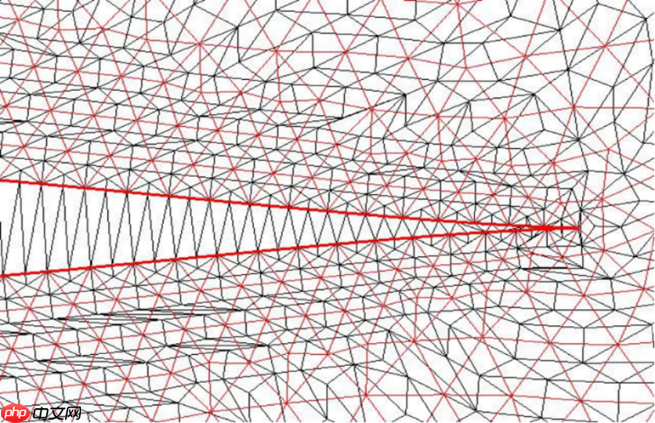This article is translated and reprinted in:cadence blog
by Veena Parthan
Computational fluid dynamics (CFD) has become an integral part of engineering decision-making processestool, which can provide in-depth revelation of the behavior characteristics of fluids in various scenarios, from the high-altitude environment of aerospace to the rapidly developing field of automotive engineering. To achieve accurate simulations of fluid dynamics, especially when dealing with complex shapes or moving parts, innovative methods are needed to construct meshes and connect data points.
This article focuses onOverlapping grid technology, focused on analysisChallenges and recent advances in interpolation in cell-centered CFD flow solvers。 At the same time, one is introducedNew dual-grid strategy, the strategy canSignificantly improve the stability and accuracy of CFD solutions。

Overview of the Overlapping Mesh Method
The overlapping mesh method, also known as nested mesh, marks a significant advancement in computational simulation flexibility. This method simplifies the process of constructing structured meshes for complex geometry by using overlapping meshes to solve domains discretely, allowing individual component meshes to fit different parts of the geometry independently. Overlapping meshes are particularly useful for simulating aerodynamic problems with objects with relative motion, such as fuel tanks dropped by airplanes or rotorcraft. In overlapping grid systems, the accuracy and stability of CFD solutions are highly dependent on the choice of interpolation method. The method must be able to achieve accurate and smooth interpolation of flow variables in a composite grid system. This process is subject to point template testing and interpolation weight definition, which directly affects the quality of the CFD solution.
Limitations of traditional interpolation methods
Traditional interpolation methods usually use least squares to determine interpolation weights, but this method has significant problems. It’s important to note that the resulting weights are not limited to a range of 0 to 1, resulting in a non-monotonic interpolation result. This can introduce new extremes into the solution, resulting in instability and inaccuracy in the CFD solution. Therefore, there is an urgent need for a way to solve these problems while maintaining efficient computing power.
Solution: Dual grid approach
The dual-grid method successfully breaks through the limitations of traditional interpolation methods, and its core lies in the construction of double-mesh cells by connecting the cell centers of the original grid, including the original grid points and their software-defined adjacency generated by the grid. Combined with threelinear interpolation, the proposed method can generate interpolation weights between 0 and 1, which effectively solves the problems caused by non-monotonic interpolation.
Comparison of structured vs. unstructured double meshes
Structured double grids benefit from the implicit connection relationship between the center of the cells, which supports direct interpolation operations. However, they cannot cover the original mesh nodes or the entire volume area, so they need to find donors in the empty area by extrapolation. In contrast, unstructured double meshes are more flexible in handling complex geometry but bring higher yieldsMemory Usageand calculate time costs. The process involves constructing bi-mesh cells (e.g., 3D tetrahedrons) that must adequately cover the original mesh cells, requiring enhanced donor search mechanisms between the original and double meshes.

Unstructured raw and double grids centered on cells
(Noak et al., 2020)
Implementation considerations
When applying the dual mesh method in practice, multiple factors need to be considered, including the choice of global double mesh or local double mesh. The former connects all cell centers but takes up a lot of memory; The latter associates double meshes individually for each original mesh, loading only the necessary local meshes for interpolation, thereby reducing memory consumption. Both the donor hexahedron used in structured bimesh, as well as the unstructured bimesh, emphasize the importance of establishing a reliable donor search mechanism within the bimesh. This is especially critical to ensure that the edge position is outside the range of the dual-mesh donor and still allows for efficient interpolation or extrapolation.

Dual network donors centered on cells with edges close to the boundary
(Noak et al., 2020)
Comparative analysis
The advantages of the dual-grid approach can be seen by comparing the use of least squares interpolation weights with compressible CFD solutions using global double-grid interpolation weights. Solutions employing least squares tend to exhibit non-monotonic behavior, potentially leading to numerical instability. The solution obtained by using double-grid interpolation weights is more stable and accurate, which verifies the effectiveness of the proposed method in solving traditional interpolation problems.
conclusion
With its inherent flexibility and ability to simulate complex geometries and moving objects, the emergence of overlapping mesh methods marks a significant advancement in the field of CFD. However, innovative methods such as the dual-grid approach are particularly important in overcoming the challenges posed by traditional interpolation methods. This method ensures that the interpolation weights are in the range of 0 to 1, thereby improving the stability and accuracy of the CFD solution. As computing power continues to improve, the integration of advanced interpolation techniques such as dual grids into CFD solvers will drive the development of computational fluid dynamics in the future, helping to achieve more efficient and reliable engineering simulations.
Future outlook
The application of the dual-grid interpolation method in CFD still needs to be further studied. Future directions may focus on improving the efficiency and speed of dual-mesh systems, such as developing better algorithms to optimize mesh settings and data point finding processes. In addition, comparative evaluation of these methods in real and complex engineering environments can help reveal their advantages and disadvantages, and provide more targeted technical support for various engineering projects. Continuous optimization of the application of grid technology, including the dual-grid approach, is crucial for driving advancements in computational fluid dynamics.
References
Ralph W. Noack, Nicholas J. Wyman, McGowan, G., and Brown, C., “Dual-Grid Interpolation for Cell-Cente.”red Overset Grid Systems” (“Dual Grid Interpolation of Cell-Centered Overlapping Grid Systems”), AIAA Paper Number: 2020-1407, January 2020.

The above is the detailed content of CFD Technical Journal|Double Grid Interpolation: Improving the Accuracy of Overlapping Grid Systems, for more information, please pay attention to other related articles on the PHP Chinese website!